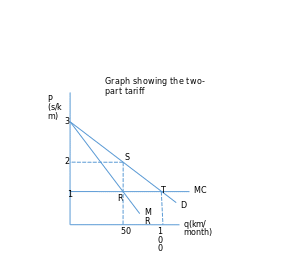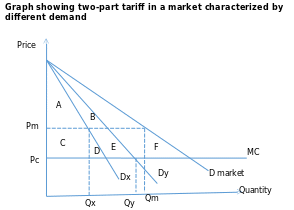Introduction
In an effort to attain their profit maximization objective, firms in different economic sectors charge different price to different customers for the same product or service. This concept is referred to as price discrimination (Fisher, Waschik & Prentice, 2010, p.44). According to Fisher, Waschik and Prentice (2010, p.45), price discrimination is practiced by all firms be it monopolies or otherwise in their pricing strategies.
Examples of firms which mostly practice price discrimination include airlines, car rentals, hotel rooms and internet providing companies. There are different forms of price discrimination that a firm can incorporate. One of the forms of price discrimination is the referred to as the two-part tariff ( Kolay & Shaffer, 2003, p. 383).
Fisher, Waschik and Prentice (2010,p.44) assert that two price tariff occurs when a firm charges an initial price (a lump-sum amount) for a particular good or service irrespective of the quantity purchased and an additional price for every unit purchased. In a market characterized by homogeneous demand, it is possible for a firm to extract the entire consumer surplus for a particular product using two-part tariffs (Smith, 2011, p. 173).
Depending on the degree of homogeneity in the market, the fixed amount charged is either equal to or higher than the marginal cost. Consumer surplus refers to the difference between the price that a consumer is willing to pay for a particular product or service and what he or she actually pays (Fisher & Waschik ,2010, p. 45)
This paper illustrates how firms use the two-part tariff to extract consumer surpluses. The author attains this by illustrating the concept of two-part tariff when the demand is homogeneous and when the demand is different.
Two-part tariffs
Monopolies determine the Price (P) of their goods and services by equating Marginal Revenue (MR) to Marginal Cost (MC). That is P=MR=MC. In this case, the price set is referred to as the single-price tariff.
By paying the price of a good or service which is equivalent to marginal revenue and marginal cost, a consumer enjoys a certain amount of consumer surplus that is not captured by the seller (Fisher, Waschik & Prentice, 2010, p.44). However, a monopoly can maximize its profit more than a firm that has adopted a single price tariff (Oi, 1971, p.78).
Goettler and Clay (2006, p.1) assert that when using the two-part tariff, a firm charges a flat fee and a per-unit tariff. For example, in its operation, Disneyland has adopted a two-part tariff in its pricing. The consumer is expected to pay a certain amount of dollars for example $ T as admission fee. The admission fee gives the consumer the right to purchase a number of rides in the park at price P.
Therefore, if the consumer purchases X number of rides, his or her budget equation will be composed of two parts which include XP+Y= M-T where M =consumer income (Oi, 1971, p. 71). The admission fee of $ T represents a privilege tax that extracts a certain percentage of the consumer’s surplus. This means that Disneyland is able to extract a certain proportion of the consumer’s income.
Two-part tariff in a homogeneous market
Consider a demand equation of a business traveler who uses taxi services to travel to his destination occasionally to be represented as P=3-0.02Q where P=price per kilometer travelled and q= number of kilometers travelled.
Assuming that the taxi company is the only firm in the industry, it enjoys a significant degree of monopoly. If the firm charges $ 1 for every kilometer travelled, this represents its Marginal Cost. Therefore, the firm’s total revenue earned from the business traveler is represented by the equation
R (Q)= P(Q)×Q= 3q-0.02q2. In order to maximize its profit, the firm will be required to ensure that its Marginal Cost is equal to Marginal Revenue. Therefore, MR=MC=3—0.04q=1
0.04q=2
Q=2/0.04
Q=0.02=50
This is illustrated by point R in the graph below.

From the consumer’s demand function, the price of travelling in the taxi is calculated as P=3-0.02×50= 2 which is depicted by point S. This means that the taxi company would maximize its profit by charging $2 for every kilometer travelled and the traveler will be required to travel a distance of 50 kilometers every month.
If this is the case, the firm’s total revenue will be $100 while its cost is $50. This means that its profit will be $50. The consumer surplus is represented by the area above the market price and below the demand curve and is calculated as;
Consumer Surplus =½(3-2) ×50=$25
Considering the pricing structure adopted, it is not possible for a monopolist to do better than this. However, the taxi company can incorporate a two-part tariff by charging a flagfall which represents a fixed charge that the consumer must pay despite the distance travelled.
This means that the firm’s total revenue will be composed of two parts, that is R= A+P.Q where A= flagfall. The part P.Q represents the variable component of the revenue which is dependent on the distance travelled. The flagfall (A) charged represents the fixed component. In the absence of the flagfall, the consumer will be required to pay $100 to travel a distance of 50 kilometers. However, the consumer may not be willing to pay $125 for the same distance, that is consumer surplus (CS)plus P.Q
CS+P.Q= $25+$100=$125.
In order to extract the consumer surplus, the taxi company will be required to set a flagfall which is equivalent to the consumer surplus of $25. The resultant effect is that the taxi company will increase its total revenue to $125, that is R= $25+$100. Additionally, its profit will increase from $50 to$75.
This illustrates that it is possible for a firm to attain its profit maximization objective by incorporating the concept of two-part tariff in its price discrimination (Fisher, Waschik & Prentice, 2010, p.44). Considering the fact that consumers are price sensitive, the taxi company should set its price per distance at a relatively low point if it is to add the fixed charge.
This will play a critical role encouraging repeat purchase behavior. The resultant effect is that the firm will be able to extract more consumer surplus using the two-part tariff. For example, if the firm sets the price of every kilometer travelled equal to its marginal cost of $1, the consumer surplus will be $100.
CS= ½[3-1] ×100= $100.
The firm will set its flagfall equivalent to 100 in order to increase its total revenue of $200. That is:
r (q)= A +p.q
r= 100+1×100= $ 200.
The firm’s total cost will be equal to $ 100 thus making a profit of $100 that is $200- $100.
At point S and T, the consumer is faced with two main outcomes. When the consumer is charged $2 per kilometer and a fixed charge is $25 at point S, the consumer travels a distance of 50 kilometers and does but does not enjoy any consumer surplus. On the other hand, when a fixed charge of $100 and a price of $1 per kilometer is charged, the consumer travels a distance of 100 kilometers with no consumer surplus. However, the firm is better off by charging the consumers a price of $1 per kilometer.
Illustration of two-part tariff when demand is different
Consider a firm that has two consumers, consumer X and consumer Y with different demands. The demand for consumer X is represented by Dx while that of consumer Y is represented by Dy. If the firm charges a fixed price represented by area AB, consumer X will be eliminated from the market.
Therefore, the firm has an option to set the price of its product at Pc and an additional fixed charge represented by area AC. If this is the case, the firm will acquire a consumer surplus represented by area ABCD. However, if the firm sets the price of its product at Pm and sells a quantity represented by Qm, it will be possible to increase its profit by an additional amount represented by E.

Conclusion
In an effort to attain their profit maximization objective, firms adopt the concept of price discrimination when formulating their pricing structure. There are different forms of pricing discrimination that a firm can adopt. One of these forms is the two-part tariffs. This price discrimination strategy is mostly applied by utility providing companies.
However, integration of two-part tariff in a firm’s pricing structure is only possible if its product or service cannot be resold by the consumers at a reasonable cost. Examples of companies that use two-part tariff in their pricing structure include airlines, hotels and car rentals.
Two-part tariffs are mostly applicable if it is possible for a firm to incorporate a connection fee in addition to the per-unit price. The concept of two-part tariffs imply that a consumer must pay a predetermined lump sum amount in order to acquire the right to purchase a product.
One of the main benefits of two-part tariff, is that it enables a firm to extract the entire consumer surplus which enhances its ability to achieve its profit maximization objective. In order to extract the entire consumer surplus, a firm should set the unit price of its good or service at a price point that is that is equivalent to its marginal cost. Additionally, the firm should also ensure that the fixed price is equivalent to the consumer surplus.
In summary, equating the price of a good or service to its marginal cost enables a firm to increase its profit. This arises from the fact that integration of a lump-sum amount or the fixed fee to the variable price enables a firm to extract the entire consumer surplus. However, if the per unit price of the good or service is above the marginal cost, the firm will not be able to increase the quantity sold.
The resultant effect is that the firm’s ability to maximize its profit by extracting the consumer surplus is limited. A firm that is able to achieve its profit maximization objective by integrating two-part tariff in its pricing is considered to perfectly price discriminate.
Reference List
Fisher, T., & Waschik, R., 2010. Managerial economics: A game theoretic approach. New York: Taylor and Francis.
Fisher, T., Waschik, R., & Prentice, D., 2010. Managerial economics: A strategic approach. New York: Taylor and Francis.
Goettler, R., & Clay, K., 2006. Price discrimination with experience goods: Sorting induced biases and illusive surplus. Arizona: Carnegie Mellon University.
Kolay, S., & Shaffer, G., 2003. Bundling and menus of two part tariffs. The Journal of Industrial Economics. Vol. 51, issue 3, pp. 383-402. Rochester, New York: Blackwell Publishers.
Oi, W., 1971. A Disneyland dilemma: Two-part tariffs for a Mickey mouse monopoly. The Quarterly Journal of Economics. Vol. 85 ,issue 1, pp. 77-96. Massachusetts: MIT Press.
Smith, T., 2011. Pricing strategy: Setting price levels, managing price discounts and establishing price structures. Mason, OH: South-Western Cengage.